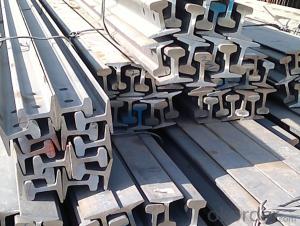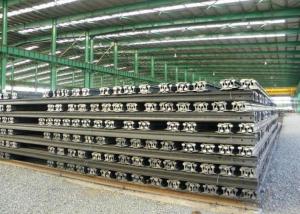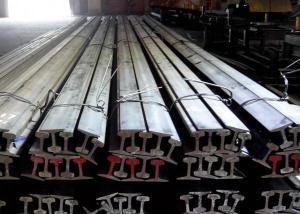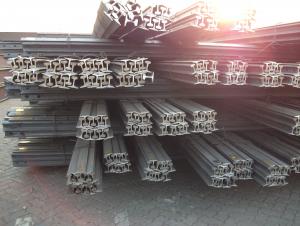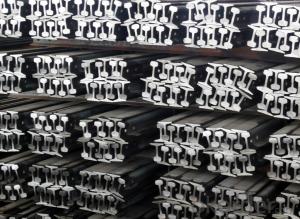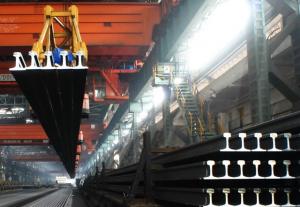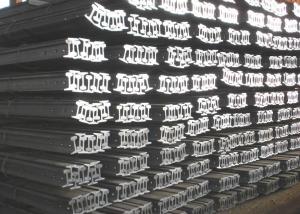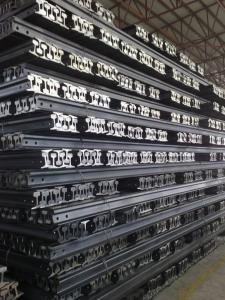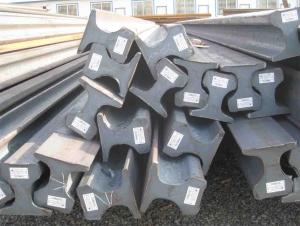Mild Steel Prime Hot Rolled Light Rail Steel
- Loading Port:
- China main port
- Payment Terms:
- TT OR LC
- Min Order Qty:
- 100 m.t.
- Supply Capability:
- 10000 m.t./month
OKorder Service Pledge
OKorder Financial Service
You Might Also Like
Item specifice
Product Description:
OKorder is offering Mild Steel Prime Hot Rolled Light Rail Steel at great prices with worldwide shipping. Our supplier is a world-class manufacturer of steel, with our products utilized the world over. OKorder annually supplies products to African, South American and Asian markets. We provide quotations within 24 hours of receiving an inquiry and guarantee competitive prices.
Product Applications:
Mild Steel Prime Hot Rolled Light Rail Steel are ideal for structural applications and are widely used in the construction of railways,mining rails, and transportation industries.
Product Advantages:
OKorder's Mild Steel Prime Hot Rolled Light Rail Steel are durable, strong, and wide variety of sizes.
Main Product Features:
· Premium quality
· Prompt delivery & seaworthy packing (30 days after receiving deposit)
· Can be recycled and reused
· Mill test certification
· Professional Service
· Competitive pricing
Product Specifications:
Manufacture: Hot rolled
Grade: Q235, 55Q,71Mn
Certificates: ISO, SGS, BV, CIQ
Length: 6m – 12m, as per customer request
Packaging: Export packing, nude packing, bundled
FAQ:
Q1: Why buy Materials & Equipment from OKorder.com?
A1: All products offered byOKorder.com are carefully selected from China's most reliable manufacturing enterprises. Through its ISO certifications, OKorder.com adheres to the highest standards and a commitment to supply chain safety and customer satisfaction.
Q2: How do we guarantee the quality of our products?
A2: We have established an advanced quality management system which conducts strict quality tests at every step, from raw materials to the final product. At the same time, we provide extensive follow-up service assurances as required.
Q3: How many tons of steel products could be loaded in containers?
A3: Usually the steel products are delivered by bulk vessel because of the large quantity and the freight. However, there are no bulk vessel enter some seaports so that we have to deliver the cargo by containers. The 6m steel product can be loaded in 20FT container, but the quantity is changed according to the size, usually from 18tons to 25tons.
Q4: what is the difference between actual weight and theoretical weight?
A4: All the section steel has two weights: actual weight and theoretical weight. Actual weight is the weighing out when the product delivered from the mill. Theoretical weight is calculated by pieces. The invoice can be based on each of them as your request.
Images:
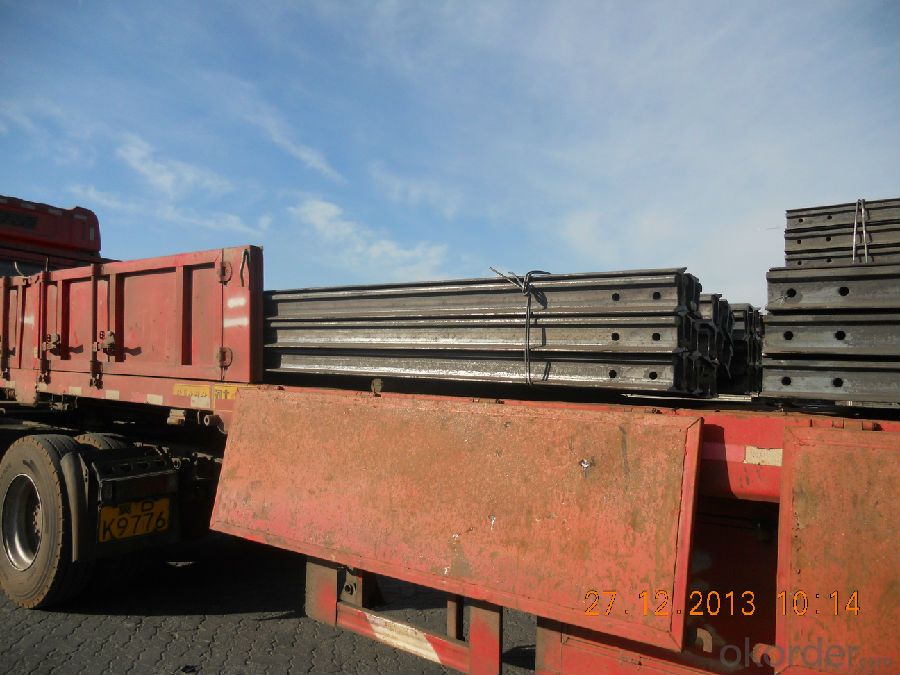
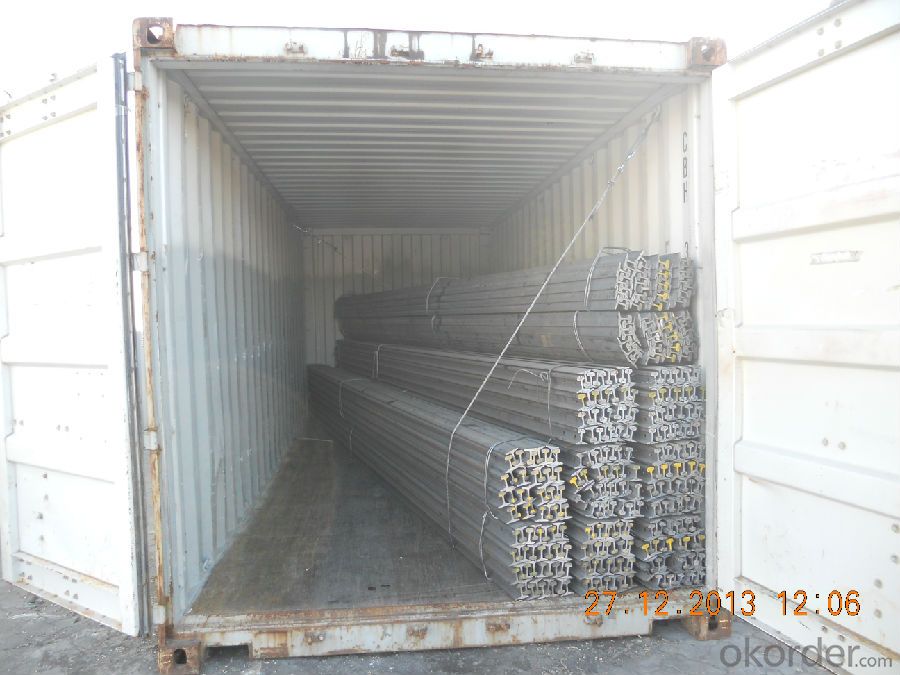
- Q:How do steel rails handle changes in track alignment due to track settlement and vertical movement caused by nearby ground excavation?
- Steel rails are designed to handle changes in track alignment caused by track settlement and vertical movement due to nearby ground excavation. They are inherently flexible and can adjust to moderate variations in the track geometry. However, excessive settlement or vertical movement can lead to track misalignment and potential derailment, so regular maintenance and monitoring are essential to ensure safe and efficient rail operations.
- Q:Can steel rails be used for industrial sidings?
- Yes, steel rails can be used for industrial sidings. Steel rails provide durability, strength, and stability, making them suitable for heavy loads and high traffic areas typically found in industrial settings.
- Q:What kind of rail needs polishing?
- Since the main rail surface defects have been eliminated by corrective or transition sanding, then preventive sanding can be carried out. The purpose of this grinding strategy is to eliminate or control the rail surface defects and ensure the rail surface state and good shape. Usually a small amount of metal (0.2~0.3mm) is removed and the grinding time is more frequent or controllable.Preventive grinding is very economical, especially if only a small amount of metal is removed, the use of grinding tools is reduced, and the service life of the rail is maximized.
- Q:How are steel rails protected against biological growth?
- Steel rails are typically protected against biological growth through regular maintenance practices such as cleaning and applying anti-biological coatings. These coatings contain chemicals that inhibit the growth of algae, moss, and other organisms, preventing them from clinging to the rails and causing damage. Additionally, proper drainage systems and regular inspections help detect and address any potential issues early on.
- Q:What are the common sizes and dimensions of steel rails?
- The common sizes and dimensions of steel rails vary depending on the specific application and region. However, some standard sizes include rail lengths of 30 feet (9.14 meters) or 60 feet (18.29 meters) with a height ranging from 5 inches (12.7 cm) to 8 inches (20.32 cm). The base width typically ranges from 4 inches (10.16 cm) to 6 inches (15.24 cm), and the overall weight per yard can range from 90 pounds (40.82 kg) to 175 pounds (79.38 kg).
- Q:How are steel rails insulated for electrified railways?
- Steel rails are insulated for electrified railways by attaching non-conductive materials such as rubber or plastic pads onto the rail ties or sleepers. This insulation prevents direct contact between the steel rails and the electric current, ensuring the safe and efficient operation of the electrified railway system.
- Q:Can steel rails be used for temporary construction purposes?
- Yes, steel rails can be used for temporary construction purposes. They are often utilized in temporary construction projects such as building scaffolding, temporary bridges, or as support structures for construction sites. Steel rails are durable, versatile, and can provide a stable base for various temporary structures.
- Q:How do steel rails contribute to train stability during turns?
- Steel rails contribute to train stability during turns by providing a smooth and sturdy surface for the train's wheels to roll on. The rails guide and support the train's wheels, preventing them from derailing or slipping off the tracks. The steel material also offers excellent strength and durability, ensuring the rails can handle the lateral forces exerted on them during turns, maintaining the stability and safety of the train.
- Q:What are the design considerations for steel rails in high-speed rail systems?
- To ensure the durability and strength required for high-speed trains, there are several crucial considerations when designing steel rails for high-speed rail systems. These considerations include the selection of the steel material, the shape and dimensions of the rail profile, the geometric alignment of the rails, the design of the track structure, the need for regular maintenance and inspection, the control of noise and vibration, accounting for thermal expansion, and ensuring compatibility with rolling stock. Firstly, the choice of steel material is essential to meet the demands of high-speed trains. Different grades of steel with properties like high tensile strength and resistance to wear and fatigue are critical. Secondly, the shape and dimensions of the rail profile play a significant role in providing stability, smoothness, and minimizing the impact on the train's wheels. Designing the profile carefully helps reduce rolling resistance and ensures proper wheel-to-rail contact. Thirdly, the geometric alignment of the rails, including curvature and elevation changes, must be meticulously crafted to allow safe and comfortable travel at high speeds. Factors like train stability, lateral forces, and passenger comfort must be taken into account. Fourthly, the design of the track structure, including rail fastening systems, sleepers or ties, and ballast, is crucial to provide stability and support for the rails. It should withstand dynamic loads imposed by high-speed trains while maintaining proper alignment and preventing track deformation. Fifthly, high-speed rail systems require regular maintenance and inspection for safety and efficiency. The design should facilitate easy access for inspection and maintenance activities, and advanced monitoring systems should be used to detect any potential defects or issues. Sixthly, measures to minimize noise and vibration levels must be considered in the design. This can include using noise barriers, resilient rail fastenings, and track damping solutions to mitigate the impact on nearby residents and infrastructure. Seventhly, designing for thermal expansion is crucial as steel rails expand and contract with temperature changes. This ensures that the rails maintain proper alignment and prevent buckling or other deformations. Lastly, the design of the steel rails must be compatible with the rolling stock, including train wheels and suspension systems. This ensures smooth and stable train operations, reducing wear and tear on both the rails and rolling stock. In conclusion, engineers must carefully consider material selection, rail profile, geometric alignment, track structure, maintenance and inspection, noise and vibration control, thermal expansion, and compatibility with rolling stock when designing steel rails for high-speed rail systems. By paying attention to these factors, engineers can create a safe, efficient, and reliable rail system for high-speed trains.
- Q:Can steel rails be used for tramway systems?
- Yes, steel rails can be used for tramway systems. Steel rails are commonly used in tramway systems due to their durability, strength, and ability to withstand heavy loads and frequent use. They provide a smooth and stable track for trams to operate on, ensuring safe and efficient transportation.
1. Manufacturer Overview |
|
|---|---|
| Location | |
| Year Established | |
| Annual Output Value | |
| Main Markets | |
| Company Certifications | |
2. Manufacturer Certificates |
|
|---|---|
| a) Certification Name | |
| Range | |
| Reference | |
| Validity Period | |
3. Manufacturer Capability |
|
|---|---|
| a)Trade Capacity | |
| Nearest Port | |
| Export Percentage | |
| No.of Employees in Trade Department | |
| Language Spoken: | |
| b)Factory Information | |
| Factory Size: | |
| No. of Production Lines | |
| Contract Manufacturing | |
| Product Price Range | |
Send your message to us
Mild Steel Prime Hot Rolled Light Rail Steel
- Loading Port:
- China main port
- Payment Terms:
- TT OR LC
- Min Order Qty:
- 100 m.t.
- Supply Capability:
- 10000 m.t./month
OKorder Service Pledge
OKorder Financial Service
Similar products
New products
Hot products
Related keywords
